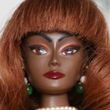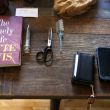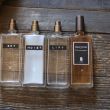“My interest in hair started when I was young, growing up in Greece. I found a ponytail of my mother’s that she had cut off when she was a child. It was quite long and thick, and I would experiment on it by bleaching it, giving it an olive oil treatment, seeing how different processes would reflect the light. It was a secret obsession. I was a boy; I wasn’t supposed to play with hair. On the down low, I would make tiny wigs for my sisters’ dolls. I was so fascinated how hair could transform them.
My background is in architecture and theater—acting. I love images, movies, and stories. It all ties together, really, because good fashion is a story, and the model is a character. Think about the images Mert and Marcus create, or Miles Aldridge—they’re like film stills from an amazing movie. So, about 10 years ago while working as an actor, I started photographing dolls that I had styled and placed in sets. People picked up on that work and I started collaborating with Japanese publications, because dolls are huge in Japan. They even celebrate dolls with a special 'Doll Day.' I collaborated with companies to develop some dolls, and eventually made a line of doll wigs for Blythe dolls. Greek Vogue saw it and, in 2010, they asked me to do a cover photo for them with a wig on a model. That went really well, and it led to another, and then another.
Now I get booked to style both real hair and wigs. And, as a reader, you’d never be able to tell if it’s a wig or not. Even when we’re working with real hair, there’s always an extra element of hairpieces and extensions involved. There’s no difference whatsoever in working with either material.
For me, working with wigs is almost a fetish. I spend the whole night before the shoot with the wig: creating it, cutting it, dyeing it, and getting to know it, so I can take it with me in the morning and transform the girl into someone else entirely—that’s what a wig is for. You don’t just throw a brunette wig on a brunette. At the end of the shoot, I get to take the wig home as a trophy. It’s fun. I have wigs that I’ve used a lot, or that had real moments, like the red wig I made for an Italian Vogue shoot with Codie Young. It looked so sensational on her that, a few weeks later, she dyed her real hair the exact shade of red we used in the story. I look at those wigs and think, ‘ We’ve done a lot together.’[Laughs] It’s creepy, I know. I also refer to the wigs as ‘she’ if it’s for a woman, or ‘he’ if it’s for a man.
Working with hair is a very intense experience for me. It’s kind of embarrassing, but I am enamored with hair—how it reacts to humidity, heat, chemicals, light, the way it can look kind of sad and forlorn when it’s just wet and hanging. It’s so beautiful. Then it can be treated with love and heat and serums, and it can become this wonderful, amazing texture that has all kinds of planes and landscapes. You can see how it moves and catches the light. It’s such a humble material, but it communicates so much.
We read people by their hair, and I can tell a lot about a person by their hair. The way we style it says a lot overall about our socioeconomic status, about our taste, health, and our age. It carries a lot of information. Volume kind of equals health; when there is more hair, you feel like that person is healthy and prosperous. I’m generalizing, but I think that we judge people by their hair very much.
Every country kind of has its own set of hair criteria. American women tend to like to wear their hair longer, and very glossy, and they like to have more of it. If they don’t have a lot of hair, they might get extensions or clip-ins. I actually make a line of impermanent extensions called SisterVeronica. I love working with real people, making custom pieces, and seeing their joy when they see themselves in the mirror, as if they’ve been upgraded. Women in Greece don’t have as much hair—I’m just speaking to what I see on the subway and on the street. In Paris, women tend to do that kind of unkempt Carine Roitfeld hair, and have a dye job that looks like it needs to be retouched—but they wear it like they mean it.
I’m more attracted to a bad dye job, or a completely fucked-up bleach job, than something perfect. I find it has more character—it’s more lyrical and luxurious. I love the sadness of hair that’s lack and limp, that doesn’t have great density, and moves more freely in the wind, than a thick, chunky Pantene head of big hair. It’s quiet, subdued, and kind of melancholic. I love a wonderful dry, long salty texture, too, that’s got a slight kink to it.
I mix a lot of styling products myself. I make my own salt spray by mixing soda water, salt, and a couple drops of serum together until it makes the hair react the way I want it to. And, in place of serums or silicones, I will combine oils with water and a drop of hair gel, and it works in a completely different way than a commercial product. But I do love the Super Skinny Serum by Paul Mitchell. It leaves absolutely no grease in your hair—it gets completely absorbed. You can use it on the most fucked-up, destroyed hair, and it will look like a million bucks, as long as you know how to use your curling iron and flat iron—you need some heat to seal it in. And Oribe’s Dry Texturizing Spray is the best thing since sliced bread. It instantly creates lifted roots, a beautiful texture throughout the hair, and it doesn’t seem to build up or kink. It’s just amazing.
I'd say I split my energy 50/50 between acting and hair. When I’m not busy with one, I’m doing the other; most often though, I do both simultaneously. I appreciate people who have their hands in more than one cookie jar.”
—as told to ITG
Thanos Samaras photographed by Emily Weiss in New York on August 6, 2013.




































